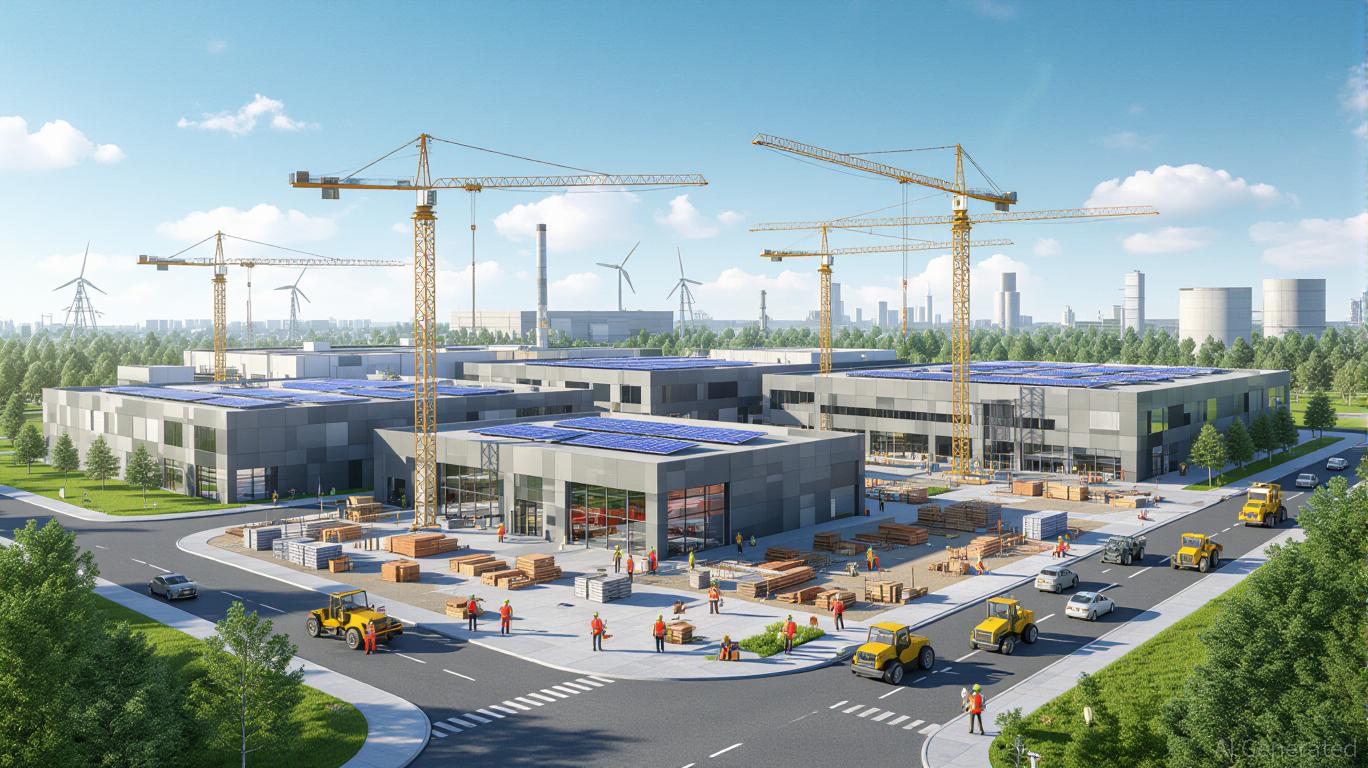The Role of Infrastructure Grants in Driving Economic Growth in Webster, NY
- Webster , NY leverages $9.8M FAST NY grant to transform Xerox campus and 600 Ridge Road site, boosting industrial real estate and mixed-use development. - Infrastructure upgrades at Xerox's 300-acre brownfield create 1M sq ft of industrial space by 2025, attracting high-tech manufacturers and aligning with state sustainability goals. - 600 Ridge Road's EPA-backed revitalization enables pedestrian-friendly mixed-use projects, synchronized with Xerox campus upgrades to drive 10.1% annual home price growth.
Webster, NY: Infrastructure Investment Fuels Industrial Growth and Community Renewal
Webster, New York, has become a prime example of how targeted infrastructure funding can drive both industrial real estate expansion and municipal revitalization. Central to this progress is a $9.8 million FAST NY grant, a state-backed program aimed at speeding up the preparation of development-ready sites. By looking at the transformation of the former Xerox campus and the redevelopment efforts at 600 Ridge Road, we can see how these grants are reshaping Webster’s economy and creating new prospects for industrial land investment in upstate New York.
FAST NY Grant Spurs Xerox Campus Transformation
The FAST NY Shovel-Ready Grant Program, with a total budget of up to $400 million across the state, has made Webster a focal point for industrial advancement. The Xerox campus, a 300-acre former brownfield, received $9.8 million to overhaul essential infrastructure such as roads, sewers, and electrical systems. These upgrades are expected to pave the way for more than one million square feet of industrial space by 2025, supporting Governor Kathy Hochul’s strategy for sustainable economic growth.

This redevelopment is a clear illustration of how public investment can attract private sector interest. The modernized campus has drawn attention from high-tech manufacturers and technology companies, positioning Webster as a center for advanced manufacturing. Statewide initiatives, including energy efficiency programs from NYSERDA, further boost the site’s attractiveness. The project also adopts a “bluefield” approach, blending residential and industrial spaces to foster vibrant, mixed-use communities that support both economic activity and quality of life.
600 Ridge Road: Turning Neglect into Opportunity
The 600 Ridge Road property, a cornerstone of the West Webster Hamlet Revitalization Project, highlights the transformative impact of infrastructure grants. In August 2025, the town cleared a derelict building that had blighted the area for over twenty years. The site is now undergoing environmental assessments, funded by a U.S. EPA brownfield grant, to evaluate soil conditions before redevelopment begins.
This effort is part of a $90,000 transportation planning initiative aimed at creating a walkable neighborhood with local amenities. The site’s close proximity to the soon-to-be-upgraded Xerox campus makes it an ideal candidate for mixed-use projects, such as cafes or essential retail, according to recent project updates. With infrastructure improvements and site readiness expected between 2025 and 2026, there is a timely opportunity for both industrial and residential investment. Webster’s median home prices are forecasted to climb by 10.1% annually, reflecting growing demand.
Regional Trends: Upstate NY’s Industrial Real Estate Surge
Webster’s progress reflects a broader pattern in upstate New York’s industrial property market. By 2025, Western New York’s industrial sector is experiencing a vacancy rate of just 2%, far below the national average of 4.8%, due to strong demand for warehouse and manufacturing facilities. Nonetheless, rising construction costs and reduced cross-border traffic from Canada present ongoing challenges.
Despite these obstacles, the region’s strategic advantages—such as proximity to the Canadian border, affordable energy, and tax incentives—continue to attract Canadian manufacturers looking to bypass tariffs. The FAST NY program’s focus on utility upgrades and environmental reviews has shortened development timelines, making sites like the Xerox campus even more appealing to investors. Notably, the $650 million fairlife® production plant, which will generate 250 new jobs, demonstrates how public investment in site preparation can unlock substantial private sector funding.
Looking Ahead: Webster as a Blueprint for Future Growth
Webster’s journey shows that infrastructure grants are more than just financial support—they are powerful drivers of comprehensive economic renewal. By tackling brownfield cleanup, improving transportation, and aligning with state sustainability objectives, Webster is setting a precedent for other communities. For investors, the coordinated completion of infrastructure and site preparation between 2025 and 2026 offers a rare chance to benefit from upstate New York’s industrial resurgence. As the region faces broader economic challenges, Webster’s strategic public-private partnerships underscore the lasting benefits of investing in foundational infrastructure to fuel long-term prosperity.
Disclaimer: The content of this article solely reflects the author's opinion and does not represent the platform in any capacity. This article is not intended to serve as a reference for making investment decisions.
You may also like
Switzerland Postpones Crypto Tax Data Exchange to Meet Technological and International Requirements
- Switzerland delays crypto tax data sharing until 2027, aligning with global regulatory reevaluations amid evolving tech and market dynamics. - SGS acquires Australia's Information Quality to boost digital revenue, reflecting Swiss firms' expansion into tech-driven compliance solutions. - Canada's Alberta oil sands policy shift highlights governments prioritizing economic growth over strict climate regulations, mirroring Switzerland's approach. - BridgeBio's precision medicine and Aires' EMF solutions dem

Switzerland's Focus on Privacy Conflicts with International Efforts for Crypto Taxation
- Switzerland delays crypto tax data sharing with international partners until 2027, contrasting with global regulatory efforts to close offshore loopholes. - The U.S. advances implementation of the OECD's CARF framework, aiming to automate reporting on foreign crypto accounts by 2029. - CARF requires foreign exchanges to report U.S. account details, mirroring traditional tax standards and targeting crypto tax evasion. - Switzerland's privacy-focused stance highlights tensions between financial confidentia

Zcash News Update: Reliance Shifts Entirely to Zcash, Citing Privacy and Regulatory Alignment
- Reliance Global Group, a Nasdaq-listed fintech firm, shifted its entire crypto portfolio to Zcash (ZEC), divesting Bitcoin , Ethereum , and other major coins. - The strategic pivot, announced November 25, prioritizes Zcash's privacy-focused zk-SNARKs technology for institutional compliance and selective data disclosure. - Zcash's 1,200% 90-day price surge and Grayscale's ETF filing highlight growing institutional interest in privacy-centric assets. - The move reflects broader crypto industry trends towar
Bitcoin News Update: Bitcoin Fear Index Drops to 22 While Investors Look for Signs of Market Rebound
- Bitcoin Fear & Greed Index rose to 22 from 20, indicating slight easing of extreme fear but persistent bearish sentiment. - Bitcoin stabilized near $87,000 after hitting $80,553, yet remains below key resistance levels amid $3.5B ETF outflows. - Structural factors like leverage and liquidations drive selloffs, with ETF redemptions correlating to 3.4% price drops per $1B outflow. - Analysts note oversold technical indicators and waning retail capitulation as potential inflection points for near-term rebou
